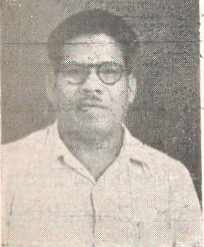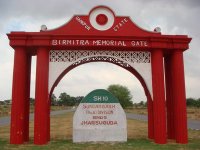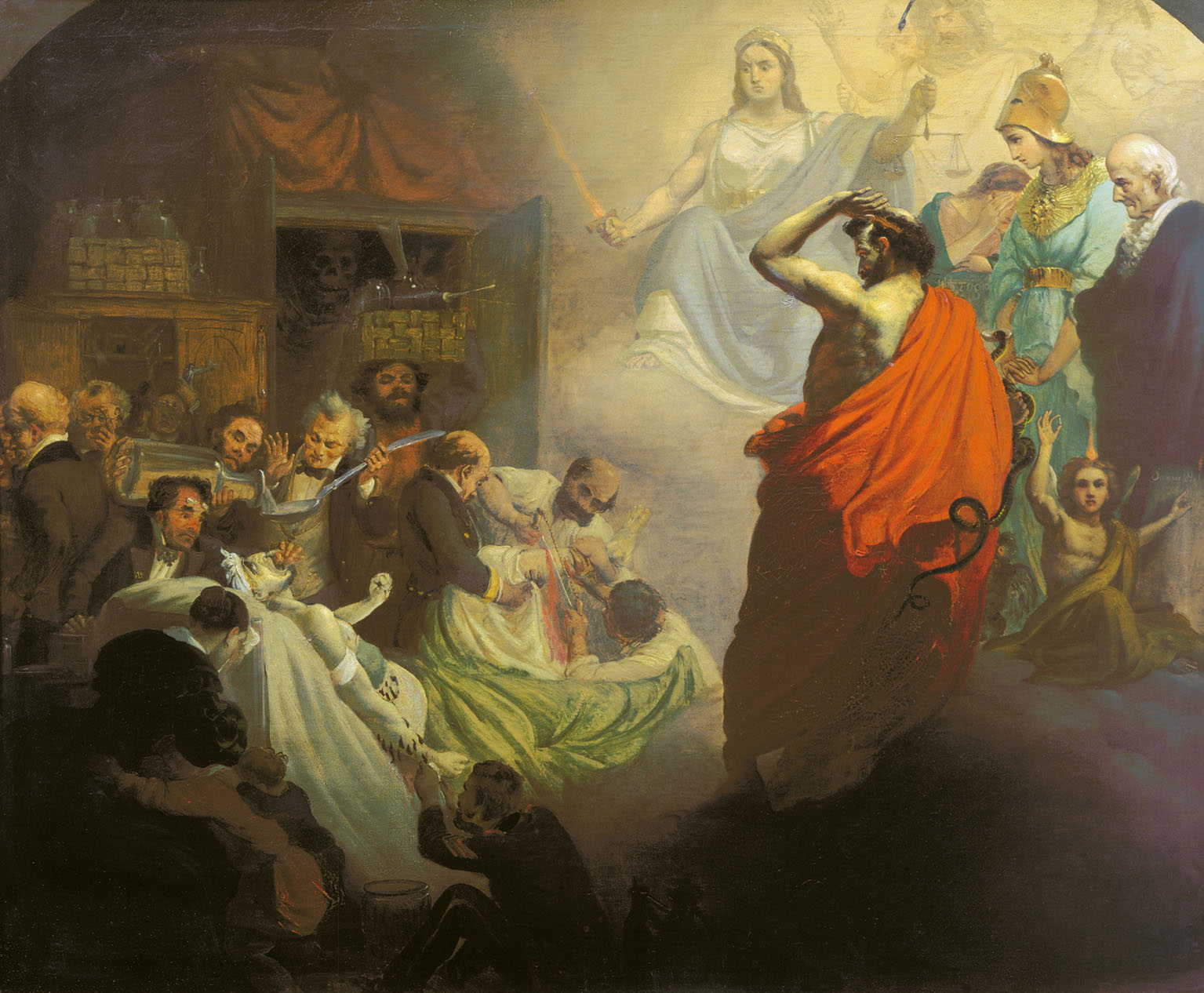|
Natabar Pandey
Dr. Natabar Pandey was an Indian politician. He represented the Sambalpur constituency in the 1st Lok Sabha (lower house of the parliament of India) elected in 1952. Pandey was born on April 5, 1908, som of Parashar Pandey. He studied at Sambalpur Zilla School and Secondary Training School, Cuttack. He married Usarani in 1928, and the couple had one daughter. From 1929 to 1938 Pandey worked as high school teacher in Sundargarh. In 1938 he renounced his teaching job and began studying homeopathy at the Institute of Homoeopathy at Dathe—Kathiawar, obtaining Ph.B. and Sc.B. degrees in Homeopathy. He served as organising secretary of the Orissa Boy Scouts Association from 1939 to 1941. Pandey was the president of the Gangpur State Praja Mandal and a member the executive xommittee of the Orissa Regional Council, and was linked to the All India States' People's Conference during 1946-1947. In 1948 he became a member of the Orissa State Assembly, as served as chief whip in the assem ... [...More Info...] [...Related Items...] OR: [Wikipedia] [Google] [Baidu] |
Sambalpur (Lok Sabha Constituency)
Sambalpur Lok Sabha constituency is one of the 21 Lok Sabha (parliamentary) constituencies in Odisha state in eastern India. This constituency covers the whole Sambalpur district and parts of Deogarh and Angul districts. Assembly segments Before delimitation, the legislative assembly segments which constituted this parliamentary constituency were: Padmapur, Melchhamunda, Bijepur, Bhatli, Bargarh, Sambalpur and Rairakhol. Following delimitation of parliamentary constituencies, this constituency presently comprises the following legislative assembly segments: Kuchinda and Deogarh assembly segments were earlier in erstwhile Deogarh constituency. Rengali assembly segment came into existence in 2008 following delimitation of legislative assembly constituencies. Members of Parliament Elected members from this constituency are: *1952: Natabar Pandey, All India Ganatantra Parishad *1957: Banamali Kumbhar, Ganatantra Parishad / Sradhakar Supakar, Ganatantra Parishad *1962: Kishe ... [...More Info...] [...Related Items...] OR: [Wikipedia] [Google] [Baidu] |
1st Lok Sabha
The First Lok Sabha was constituted on 17 April 1952 after India's first general election. The 1st Lok Sabha lasted its full tenure of five years and was dissolved on 4 April 1957. The First Session of this Lok Sabha commenced on 13 May 1952. Total Lok Sabha seats were 489 and total eligible voters were 17.3 crores. The Indian National Congress (INC) won 364 seats. They were followed by Independents, winning a total of 37 seats. The Communist Party of India (CPI) and the Socialist Party (India) followed with 16 and 12 seats respectively. Indian National Congress got 45% of the total votes in this election and won 76% of the 479 contested seats. Lok Sabha officers As per Article 93 of Constitution of India, the Lok Sabha must have elected and non-elected officers. The elected members are Speaker and the Deputy Speaker whereas the non-elected members are the Secretariat staff. Following were the 1st Lok Sabha officers and other important members. a. (Not Officially Declared) ... [...More Info...] [...Related Items...] OR: [Wikipedia] [Google] [Baidu] |
Parliament Of India
The Parliament of India (International Alphabet of Sanskrit Transliteration, IAST: ) is the supreme legislative body of the Republic of India. It is a bicameralism, bicameral legislature composed of the president of India and two houses: the Rajya Sabha (Council of States) and the Lok Sabha (House of the People). The president in his role as head of the legislature has full powers to summon and prorogue either house of Parliament or to dissolve the Lok Sabha. The president can exercise these powers only upon the advice of the prime minister of India, prime minister and his Union Council of Ministers. Those elected or nominated (by the president) to either house of Parliament are referred to as member of Parliament (India), members of Parliament (MPs). The member of Parliament, Lok Sabha, members of parliament of the Lok Sabha are direct election, directly elected by the Indian public voting in single-member districts and the member of Parliament, Rajya Sabha, members of parliam ... [...More Info...] [...Related Items...] OR: [Wikipedia] [Google] [Baidu] |
1952 Indian General Election
Year 195 ( CXCV) was a common year starting on Wednesday (link will display the full calendar) of the Julian calendar. At the time, it was known as the Year of the Consulship of Scrapula and Clemens (or, less frequently, year 948 ''Ab urbe condita''). The denomination 195 for this year has been used since the early medieval period, when the Anno Domini calendar era became the prevalent method in Europe for naming years. Events By place Roman Empire * Emperor Septimius Severus has the Roman Senate deify the previous emperor Commodus, in an attempt to gain favor with the family of Marcus Aurelius. * King Vologases V and other eastern princes support the claims of Pescennius Niger. The Roman province of Mesopotamia rises in revolt with Parthian support. Severus marches to Mesopotamia to battle the Parthians. * The Roman province of Syria is divided and the role of Antioch is diminished. The Romans annexed the Syrian cities of Edessa and Nisibis. Severus re-establish his he ... [...More Info...] [...Related Items...] OR: [Wikipedia] [Google] [Baidu] |
Sundargarh
Sundergarh is a town in Sundergarh district of the Indian state of Odisha. As of 2011 2011 Census of India, census, the municipality had a population of 45,036. Sundargarh is recognized as an industrial district in Odisha. Steel, fertilizer, cement, ferrovanadium, machine-building, glass, china-clay plants and factories, and spinning mills are some of the major industries of this district. Sundargarh occupies a prominent position in the mineral map of Odisha and is rich in iron ore, limestone, and manganese. Geography Sundargarh is located at . It has an average elevation of 243 metres (801 feet). The Ib river flows along in the north. Climate The climate of this district is characterized by extremely hot summers and cool winters. The climate is hot and moist sub-humid. The normal rainfall of the district is approximately 1230 mm, but there is a deviation in receipt of rainfall pattern which is influencing crop production. History Sundargarh was the capital of ... [...More Info...] [...Related Items...] OR: [Wikipedia] [Google] [Baidu] |
Homeopathy
Homeopathy or homoeopathy is a pseudoscientific system of alternative medicine. It was conceived in 1796 by the German physician Samuel Hahnemann. Its practitioners, called homeopaths, believe that a substance that causes symptoms of a disease in healthy people can cure similar symptoms in sick people; this doctrine is called '' similia similibus curentur'', or "like cures like". Homeopathic preparations are termed ''remedies'' and are made using homeopathic dilution. In this process, the selected substance is repeatedly diluted until the final product is chemically indistinguishable from the diluent. Often not even a single molecule of the original substance can be expected to remain in the product. Between each dilution homeopaths may hit and/or shake the product, claiming this makes the diluent remember the original substance after its removal. Practitioners claim that such preparations, upon oral intake, can treat or cure disease. All relevant scientific knowledge about ... [...More Info...] [...Related Items...] OR: [Wikipedia] [Google] [Baidu] |
Homeopathy
Homeopathy or homoeopathy is a pseudoscientific system of alternative medicine. It was conceived in 1796 by the German physician Samuel Hahnemann. Its practitioners, called homeopaths, believe that a substance that causes symptoms of a disease in healthy people can cure similar symptoms in sick people; this doctrine is called '' similia similibus curentur'', or "like cures like". Homeopathic preparations are termed ''remedies'' and are made using homeopathic dilution. In this process, the selected substance is repeatedly diluted until the final product is chemically indistinguishable from the diluent. Often not even a single molecule of the original substance can be expected to remain in the product. Between each dilution homeopaths may hit and/or shake the product, claiming this makes the diluent remember the original substance after its removal. Practitioners claim that such preparations, upon oral intake, can treat or cure disease. All relevant scientific knowledge about ... [...More Info...] [...Related Items...] OR: [Wikipedia] [Google] [Baidu] |
Chief Whip
The Chief Whip is a political leader whose task is to enforce the whipping system, which aims to ensure that legislators who are members of a political party attend and vote on legislation as the party leadership prescribes. United Kingdom In British politics, the Chief Whip of the governing party in the House of Commons is usually also appointed as Parliamentary Secretary to the Treasury, a Cabinet position. The Government Chief Whip has an official residence at 12 Downing Street. However, the Chief Whip's office is currently located at 9 Downing Street. The Chief Whip can wield great power over their party's MPs, including cabinet ministers, being seen to speak at all times with the voice of the Prime Minister. Margaret Thatcher was known for using her Chief Whip as a "cabinet enforcer". The role of Chief Whip is regarded as secretive, as the Whip is concerned with the discipline of their own party's Members of Parliament, never appearing on television or radio in thei ... [...More Info...] [...Related Items...] OR: [Wikipedia] [Google] [Baidu] |
All India Ganatantra Parishad
The Ganatanra Parishad (GP) or the All India Ganatantra Parishad (AIGP) was a regional political party based in Orissa state in eastern India from 1950 to 1962. This political party was formed by the former rulers of the erstwhile princely states and big landlords. It was founded in 1950 and Rajendra Narayan Singh Deo became its president. In 1962, this political party was merged with the Orissa unit of the Swatantra Party. after the parliamentary election. Background The roots of this party can be traced to the Koshal Utkal Praja Parishad founded in October, 1948 with its headquarters at Sambalpur. The first meeting of the Praja Parishad was held on 8, 9 and 10 October 1948 at Balibandha in Sambalpur. In the annual meeting of the Praja Parishad at Bolangir in October, 1950 it was transformed into a full-fledged political party, the Ganatantra Parishad. Performance in the elections In the first general election in 1951, the GP won 0.91% of the total votes and 6 seats in the Lok ... [...More Info...] [...Related Items...] OR: [Wikipedia] [Google] [Baidu] |
Odisha
Odisha (English: , ), formerly Orissa ( the official name until 2011), is an Indian state located in Eastern India. It is the 8th largest state by area, and the 11th largest by population. The state has the third largest population of Scheduled Tribes in India. It neighbours the states of Jharkhand and West Bengal to the north, Chhattisgarh to the west, and Andhra Pradesh to the south. Odisha has a coastline of along the Bay of Bengal in Indian Ocean. The region is also known as Utkala and is also mentioned in India's national anthem, " Jana Gana Mana". The language of Odisha is Odia, which is one of the Classical Languages of India. The ancient kingdom of Kalinga, which was invaded by the Mauryan Emperor Ashoka (which was again won back from them by King Kharavela) in 261 BCE resulting in the Kalinga War, coincides with the borders of modern-day Odisha. The modern boundaries of Odisha were demarcated by the British Indian government when Orissa Province wa ... [...More Info...] [...Related Items...] OR: [Wikipedia] [Google] [Baidu] |
India MPs 1952–1957
India, officially the Republic of India (Hindi: ), is a country in South Asia. It is the seventh-largest country by area, the second-most populous country, and the most populous democracy in the world. Bounded by the Indian Ocean on the south, the Arabian Sea on the southwest, and the Bay of Bengal on the southeast, it shares land borders with Pakistan to the west; China, Nepal, and Bhutan to the north; and Bangladesh and Myanmar to the east. In the Indian Ocean, India is in the vicinity of Sri Lanka and the Maldives; its Andaman and Nicobar Islands share a maritime border with Thailand, Myanmar, and Indonesia. Modern humans arrived on the Indian subcontinent from Africa no later than 55,000 years ago., "Y-Chromosome and Mt-DNA data support the colonization of South Asia by modern humans originating in Africa. ... Coalescence dates for most non-European populations average to between 73–55 ka.", "Modern human beings—''Homo sapiens''—originated in Africa. Then, inter ... [...More Info...] [...Related Items...] OR: [Wikipedia] [Google] [Baidu] |






